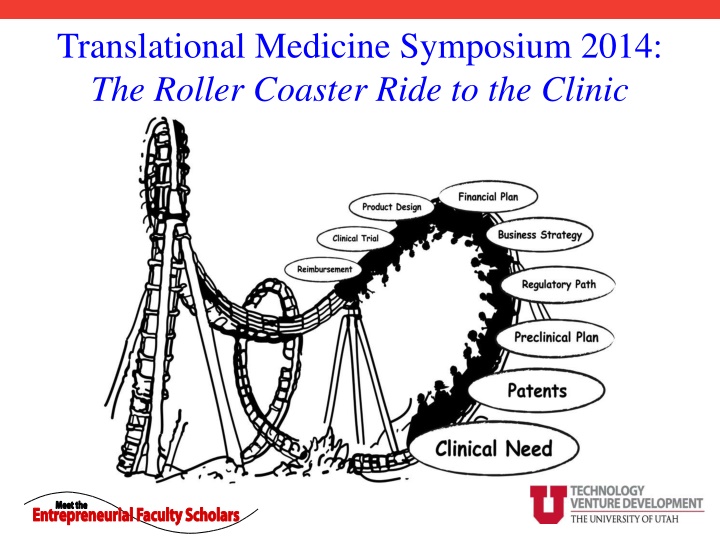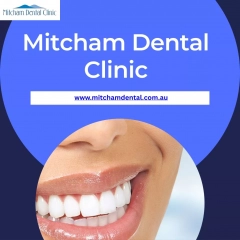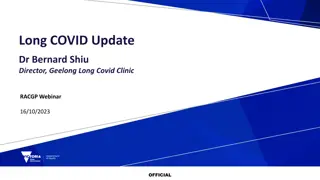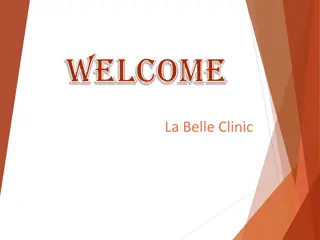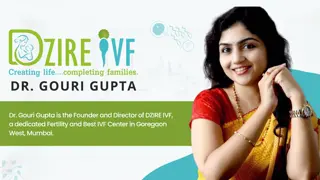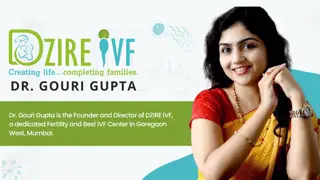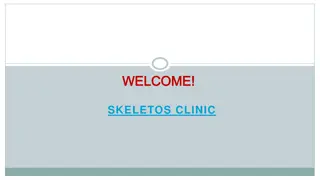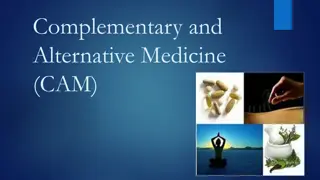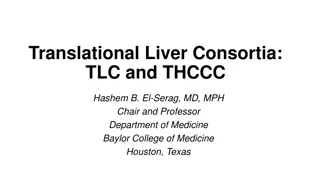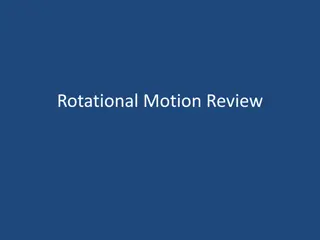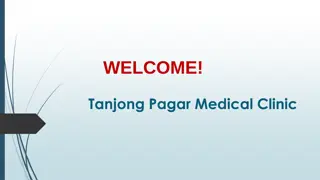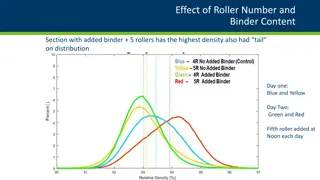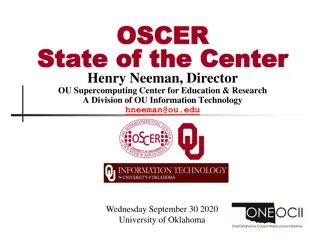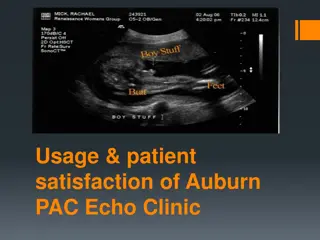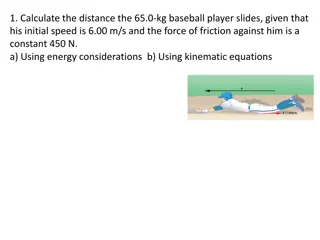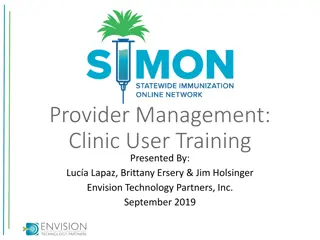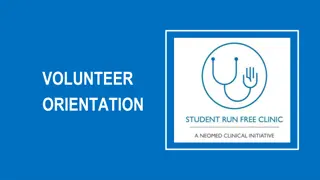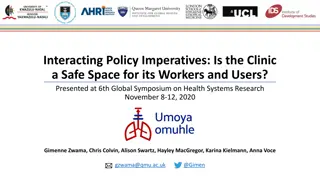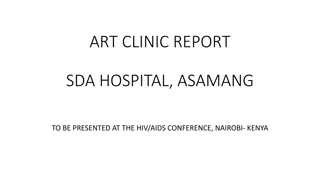2014 Translational Medicine Symposium: Roller Coaster Ride Clinic
Journey through the roller coaster ride of translational medicine at the 2014 Symposium, exploring the path to clinic success from research to application. Discover the latest advancements and challenges in bridging the gap between bench and bedside, with key insights and discussions from leading experts in the field. Gain a valuable perspective on the dynamic landscape of translational medicine and its impact on healthcare innovation and patient outcomes.
Uploaded on Mar 08, 2025 | 2 Views
Download Presentation

Please find below an Image/Link to download the presentation.
The content on the website is provided AS IS for your information and personal use only. It may not be sold, licensed, or shared on other websites without obtaining consent from the author.If you encounter any issues during the download, it is possible that the publisher has removed the file from their server.
You are allowed to download the files provided on this website for personal or commercial use, subject to the condition that they are used lawfully. All files are the property of their respective owners.
The content on the website is provided AS IS for your information and personal use only. It may not be sold, licensed, or shared on other websites without obtaining consent from the author.
E N D
Presentation Transcript
Translational Medicine Symposium 2014: The Roller Coaster Ride to the Clinic
Translational Medicine Symposium 2014 Preclinical Development Bench to Business to Bedside: Clearing the Hurdles to the Clinic
Introductions Moderator: Barbara Wirostko M.D. (Moran Eye Institute, CSO Jade Therapeutics, Inc.) Panelists: Robert Selliah Ph.D. ( CEO American MedChem Nonprofit Corporation) Flagg Flanagan, Ph.D. President & CEO, Discgenics
Discussion Points Diseases, Mechanisms, Signaling Pathways & Targets Drug Discovery toward Preclinical Candidate Selection IND enabling Studies toward IND Filing & Clinic
Drug Discovery and Development How are drugs discovered and developed? Translational Medicine Workshop: Preclinical Development 5
A Slow and Costly Process Stage 1 Drug Discovery Stage 2 Preclinical Stage 3 Clinical Trials Stage 4 FDA Review Phase 1 Phase 3 20-100 Volunteers 1,000-5,000 Volunteers IND Submission NDA Submitted 1 FDA Approved Drug 250 10,000 Compounds 5 Compounds Compounds Phase 2 100-500 Volunteers 6.5 Years 7 Years 1.5 Years Source: Pharmaceutical Research and Manufacturers of America Translational Medicine Workshop: Preclinical Development 6
Why Compounds Fail or Slow Down in Development SLOWED DEVELOPMENT FAILURE Synthetic Complexity Low Potency Ambiguous Toxicity Finding Inherently Time- Intensive Target Indication Poor Biopharm Properties Market Reasons Poor PK Profile Lack of Efficacy Toxicity Tufts Center for the Study of Drug Development, Tufts University Translational Medicine Workshop: Preclinical Development 7
Drug Discovery to IND Hit Identification Identification Target Lead Lead Preclinical Development Identification and Validation Optimization Molecular target proposed/identified High-Throughput Screening of compound library Medicinal chemistry effort to turn hits into leads Potency and selectivity Extensive med chem to improve potency and selectivity In vivo efficacy in additional models GLP-compliant toxicology and PK studies Biological hypothesis relevant to disease Virtual or in silico screening GLP-compliant safety pharmacology studies Drug formulation Genetic models to demonstrate proof of concept Confirm potency and selectivity of hits in 1o and 2o assays Initial in vitro pharmacokinetic (PK) assessment In vitro PK: CYP inhibition, metabolic stability In vivo efficacy in relevant animal models of disease In vivo PK characterization Initial dose- ranging toxicology studies Pre-IND meeting with FDA Translational Medicine Workshop: Preclinical Development 8
Identifying Drug Targets Drug Targets Enzymes, receptors, protein-protein interactions (e.g gene, key enzyme, receptor, ion-channel, nuclear receptor) Biological system, signaling pathways Translational Medicine Workshop: Preclinical Development 9
Discovery Biology Disease of Interest (unmet medical need): understand the mechanism of disease and its progression Identify a viable therapeutic target and validate Knock-out studies in whole cell or animal models RNAi, antibodies, tool compounds Develop and validate robust biological assays for testing compounds Whole cell, transformed cells, cell-free biochemical Translational Medicine Workshop: Preclinical Development 10
Screening for Hit Identification State-of-the-art technology is available to screen large libraries of compounds against various types biological assays Compounds which affect the assay in a favorable manner are called Hits Each set of hits are tested separately against the target assay to identify validated hits Translational Medicine Workshop: Preclinical Development 11
Discovery Chemistry or Medicinal Chemistry Iterative Process Start with hits and create lead compounds (a.k.a., Hit-to-Lead, H2L) Synthesize and test analogs of hits to optimize certain properties: biological activity (potency), identify off target effects, selectivity (related or unrelated targets to avoid side effects or toxicity) Use drug design to create novel compounds and optimal compounds Computer-aided drug design (CADD) Intuitive drug design based on medicinal chemistry experience Novel compounds could result in valuable intellectual property (IP) In vitro ADME characterization of optimized compounds Explore proof of concept efficacy in animal models (non GLP) Translational Medicine Workshop: Preclinical Development 12
Another Way to Find Leads Modify Existing Active Compound NH2 N(CH3)2 H N HO H3C S O O Many steps N N H H 5-Hydroxytryptamine (5-HT) Serotonin (a natural neurotransmitter synthesized in certain neurons in the CNS) Sumatriptan (Imitrex) Used to treat migrain headaches known to be a 5-HT1 agonist Design structural changes and create compounds to: Improve biological activity and selectivity for the target Eliminate side effects Carve out patent space (IP) Improve physicochemical properties Improve therapeutic index (TI) (effectiveness vs. unfavorable side effects) Translational Medicine Workshop: Preclinical Development 13
Lead Optimization Iterative Process Identify optimal compound(s) for preclinical studies with favorable parameters synthetic scalability in vitro potency and selectivity In vivo efficacy in proof of concept and diseases models toxicology (dose-ranging toxicology studies in vivo) patentability In vivo pharmacokinetics (PK: half-life, Cmax, Tmax, etc) in vitro ADME characterization Optimal mode of delivery Highly collaborative work with pharmacology, toxicology, biology, process chemistry, patent law, etc Translational Medicine Workshop: Preclinical Development 14
Goal - Get to an IND Application (Investigational New Drug) Stage 1 Drug Discovery Stage 2 Preclinical Stage 3 Clinical Trials Stage 4 FDA Review Phase 1 Phase 3 20-100 Volunteers 1,000-5,000 Volunteers IND Submission NDA Submitted 1 FDA Approved Drug 250 10,000 Compounds 5 Compounds Compounds Phase 2 100-500 Volunteers 6.5 Years 7 Years 1.5 Years Source: Pharmaceutical Research and Manufacturers of America Translational Medicine Workshop: Preclinical Development 15
IND process What is an IND What are GXP criteria FDA expectations Real life example
Investigational New Drug Application (IND) Primary goal - present the data package to the FDA to allow the initiation of the clinical program: To present data to justify that the compound exhibits pharmacological activity to meet an unmet need, To support the product being reasonably safe for initial use in humans, To justify exposing humans to reasonable risks when used in limited, early-stage clinical studies. http://www.fda.gov/Drugs/DevelopmentApprovalProcess/HowDrugsareDevelopedandApproved/ApprovalApplications/Investigational NewDrugINDApplication/default.htm#FDA Guidances for Investigational New Drugs Translational Medicine Workshop: Preclinical Development 17
IND (Investigational New Drug) Application The IND application must contain information in three broad areas: Manufacturing Information (GMP) - Information pertaining to the composition, manufacturer, stability, and controls used for manufacturing the drug substance and the drug product. This information is assessed to ensure that the company can adequately produce and supply consistent batches of the drug. Animal Pharmacology and Toxicology Studies (GLP) - Preclinical data to permit an assessment as to whether the product is reasonably safe for initial testing in humans. Also included are any previous experience with the drug in humans (often foreign use). Clinical Protocols and Investigator Information (GCP)- Detailed protocols for proposed clinical studies to assess whether the initial-phase trials will expose subjects to unnecessary risks. Also, information on the qualifications of clinical investigators - professionals (generally physicians) who oversee the administration of the experimental compound - to assess whether they are qualified to fulfill their clinical trial duties. Finally, commitments to obtain informed consent from the research subjects, to obtain review of the study by an institutional review board (IRB), and to adhere to the investigational new drug regulations http://www.fda.gov/Drugs/DevelopmentApprovalProcess/HowDrugsareDevelopedandApproved/ApprovalApplications/Investigational NewDrugINDApplication/default.htm#FDA Guidances for Investigational New Drugs Translational Medicine Workshop: Preclinical Development 18
GxP Criteria Quality systems and requirements (quality control and assurance (QC and QA)) that have been put into place to ensure the uniformity, consistency, reliability, quality and integrity of the product manufacturing, toxicology and clinical trial conduct. GMP Good Manufacturing Practice GLP Good Laboratory Practice GCP Good Clinical Practice Code of Federal Regulations (CFR 21) http://www.fda.gov/ScienceResearch/SpecialTopics
IND Enabling Preclinical Studies Efficacy pharmacology (animal models) Safety pharmacology General toxicology oral and specific route of administration Genetic toxicology (geno tox) Pharmacokinetics (PK- local and systemic) ADME (absorption, distribution, metabolism, excretion) Reproductive toxicology Carcinogenicity ( ask for a waiver based on genotox) Special studies Translational Medicine Workshop: Preclinical Development 20
IND Enabling Studies Needed Will determine with FDA during the pre IND meeting What studies are needed dependent on product & indication Who are the patients ? What is the unmet need ? What is the expected dosing acute or chronic? Where will it be delivered systemic or local? Need to demonstrate safety preclinically for that First in Human Study (FIH)
Ophthalmology: topical NCE NCE (new chemical entity) for glaucoma First study was a 28 day study in subjects WITH glaucoma > 45 yrs of age Systemic safety 0ral in 2 species Local tolerability for 28 days in 2 species NCE genotox studies (DNA damage) Older population (No reprotox for the first studies) Carcinogenicity studies during clinical development Chronic tox AHEAD of the longer phase 2/3 studies
Conclusion Drug discovery from target identification to IND filing is a long process Highly collaborative process expertise comes from biology, genetics, medicinal chemistry, pharmacology, toxicology, process chemistry, computational design & regulatory Yet, this is how we discover drugs which help heal patients, provide comfort, reduce pain, and allow for longer and improve quality of life
Q & A http://www.swapmeetdave.com/Humor/C-Lawyer-Disclaimer.jpg
Finding the Lead (cont.) Enhance a side effect http://drugline.org/img/drug/lumigan-13896_3.jpg http://www.vitalitymedicalspa.com/images/Latisse_logo.jpg http://www.drobinsonmd.com/images/before-after-latisse.jpg http://www.cyberounds.com/assets/05/28/528/figure1.jpg Translational Medicine Workshop: Preclinical Development February 19, 2013 25
Pharmacology In Vivo animal models to demonstrate efficacy Efficacy studies are conducted more for candidate selection/ prioritization Understanding the pharmacology impacts interpretation of toxicology studies Translational Medicine Workshop: Preclinical Development February 19, 2013 26
Safety Pharmacology Investigate potential undesirable pharmacodynamic effects on the physiological function of vital organs Generally given at higher than indicated dose orally Core battery Cardiovascular system Respiratory system Central nervous system Translational Medicine Workshop: Preclinical Development February 19, 2013 27
General Toxicology Pivotal to determining whether the proposed clinical trial is safe to proceed Identify toxicities (doses) to be avoided Direct monitoring in the clinic Calculate safety margins (exposure at the NOAEL/ clinical exposure) Species selection Dose selection Duration of administration Route of administration Endpoints Translational Medicine Workshop: Preclinical Development February 19, 2013 28
General Toxicology Species Selection Two species including one rodent Typically mouse or rat and dog or primate Metabolic profile should be similar to human Rodent specific metabolite could lead to a positive genotox signal (clastogen or anagen) Translational Medicine Workshop: Preclinical Development February 19, 2013 29
General Toxicology Dose Selection Selection 1 Dosing should be up to Maximum Tolerated Dose Dosing should include a No Adverse Effect level (NOAEL) Doses should be spaced so to allow a dose response assessment Generally 3 dose groups and a control group Selection 2 Dosing should NOT be determined merely by multiples of the human dose Dosing regimen can be adjusted to mimic human exposure If t is shorter in animals than humans such that exposure with daily dosing is limited, give drug multiple times per day Translational Medicine Workshop: Preclinical Development February 19, 2013 30
General Toxicology Duration of Dosing For initial clinical trials (up to 2 weeks duration) 2 weeks toxicology studies needed For later clinical trials, animal studies must be of equal duration Can be managed sequentially if preclinical is run staggered with clinical Need to discuss with FDA Translational Medicine Workshop: Preclinical Development February 19, 2013 31
General Toxicology Route of administration Same as clinical route If adequate systemic exposure cannot be achieved by the clinical route supplement with systemic dosing There does exist evidence that Avastin gets into the systemic vasculature with ocular dosing Translational Medicine Workshop: Preclinical Development February 19, 2013 32
General Toxicology Endpoints Mortality Clinical signs Body weight, temperature, activity level Hematology Clinical chemistry Toxicokinetics Pathology (complete battery of tissues) Translational Medicine Workshop: Preclinical Development February 19, 2013 33
Genetic Toxicology Core battery of tests Microbial mutation test (AMES) In vitro mammalian chromosomal aberration or mouse lymphoma tk test In vivo micronucleus test ( clastogen or anagen) First 2 submitted with initial IND Last test submitted prior to Phase 2 Positive signal may lead to additional testing Data conveyed in the label Translational Medicine Workshop: Preclinical Development February 19, 2013 34
Pharmacokinetics Parameters include AUC, Cmax, Tmax t , CI< vol of distribution Exposure parameters allow comparisons to be made with clinical data so that safety margins can be calculated Single and repeat dose studies to address accumulation and induction of metabolism Translational Medicine Workshop: Preclinical Development February 19, 2013 35
Reproductive Toxicology Three types of studies Fertility and early embryonic development Embryofetal development Peri and post natal development Combined studies are acceptable but require complex designs Data will be conveyed in the drug label Translational Medicine Workshop: Preclinical Development February 19, 2013 36
Carcinogenicity Performed for Chronic use drugs Continuous use for 6 months or more Chronic intermittent use Performed for drugs for which there is concern based on Drug class Structure activity relationship Preneoplastic lesions identified in the tox studies Long term tissue retension Long Studies - start early in clinical development Translational Medicine Workshop: Preclinical Development February 19, 2013 37
IND (Investigation New Drug) Application The following regulations apply to the IND application process: 21CFR Part 312 Investigational New Drug Application 21CFR Part 314 INDA and NDA Applications for FDA Approval to Market a New Drug (New Drug Approval) 21CFR Part 316 Orphan Drugs 21CFR Part 58 Good Lab Practice for Nonclinical Laboratory [Animal] Studies 21CFR Part 50 Protection of Human Subjects 21CFR Part 56 Institutional Review Boards 21CFR Part 201 Drug Labeling 21CFR Part 54 Financial Disclosure by Clinical Investigators http://www.fda.gov/Drugs/DevelopmentApprovalProcess/HowDrugsareDevelopedandApproved/ApprovalApplications/Investigational NewDrugINDApplication/default.htm#FDA Guidances for Investigational New Drugs Translational Medicine Workshop: Preclinical Development February 19, 2013 38
Serendipity: a chance occurrence Must be accompanied by an experimentalist who understands the big picture (and is not solely focused on his/her immediate research goal), who has an open mind toward unexpected results, and who has the ability to use deductive logic in the explanation of such results. Example: Penicillin discovery Example: development of Viagra to treat erectile dysfunction Translational Medicine Workshop: Preclinical Development February 19, 2013 39
